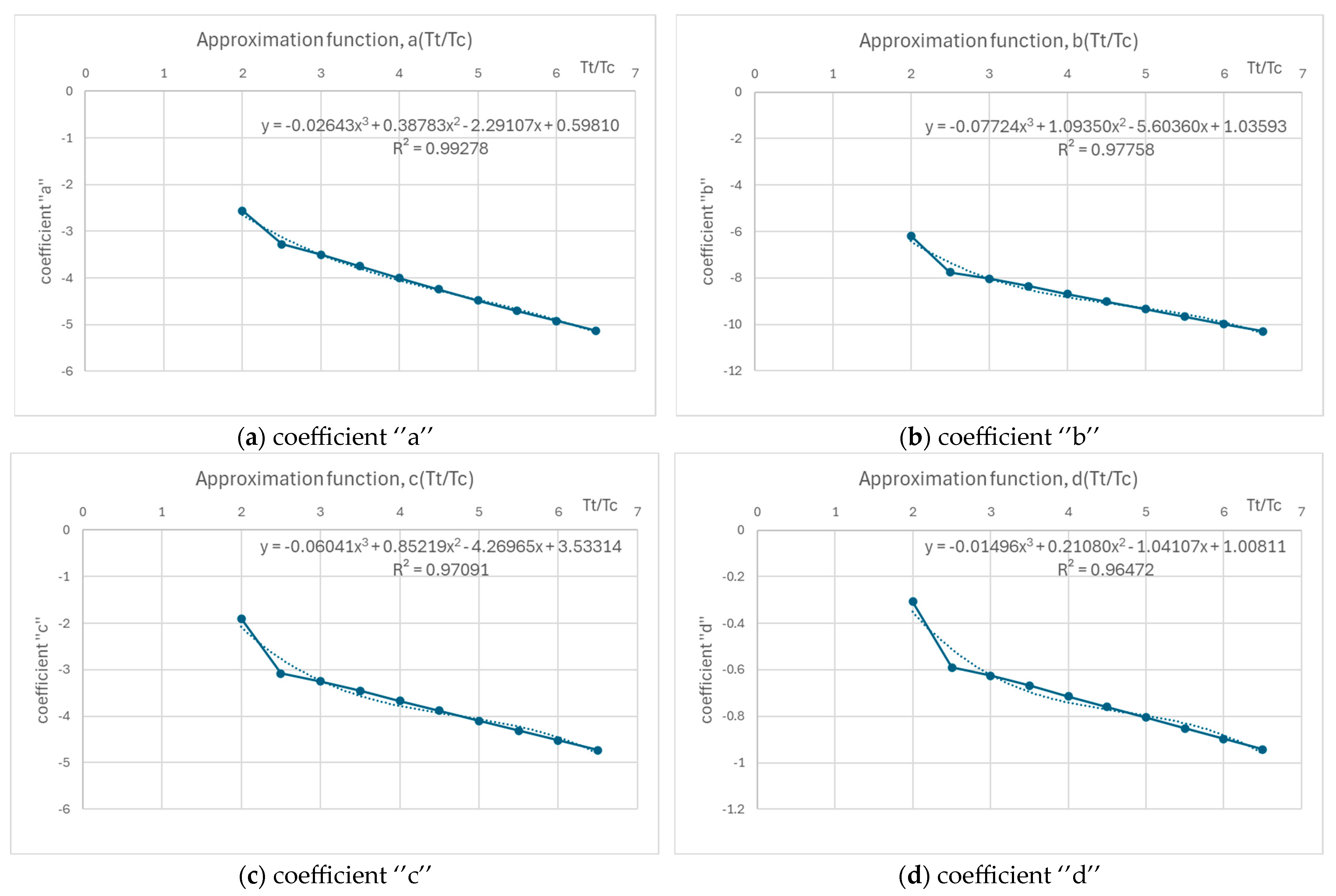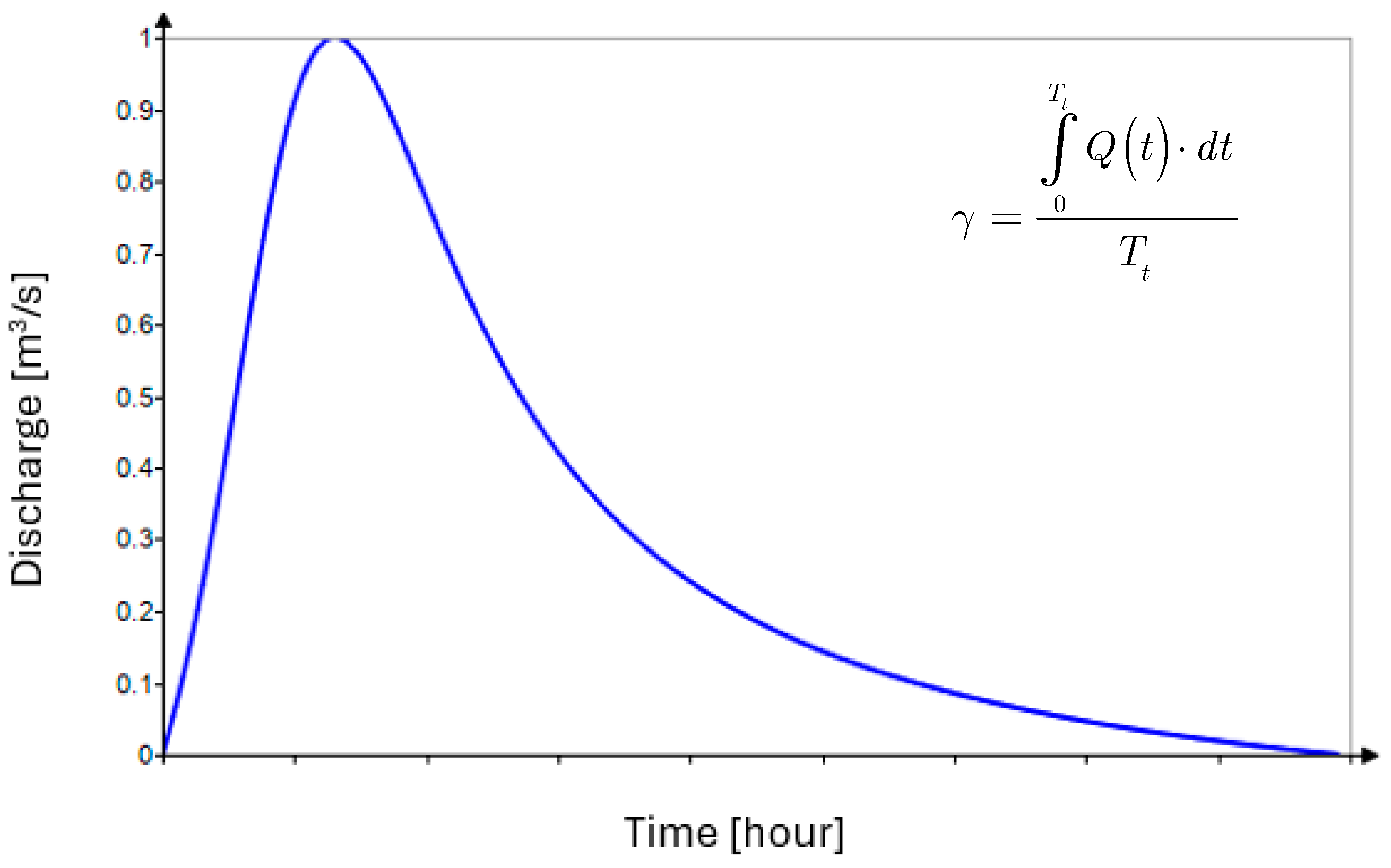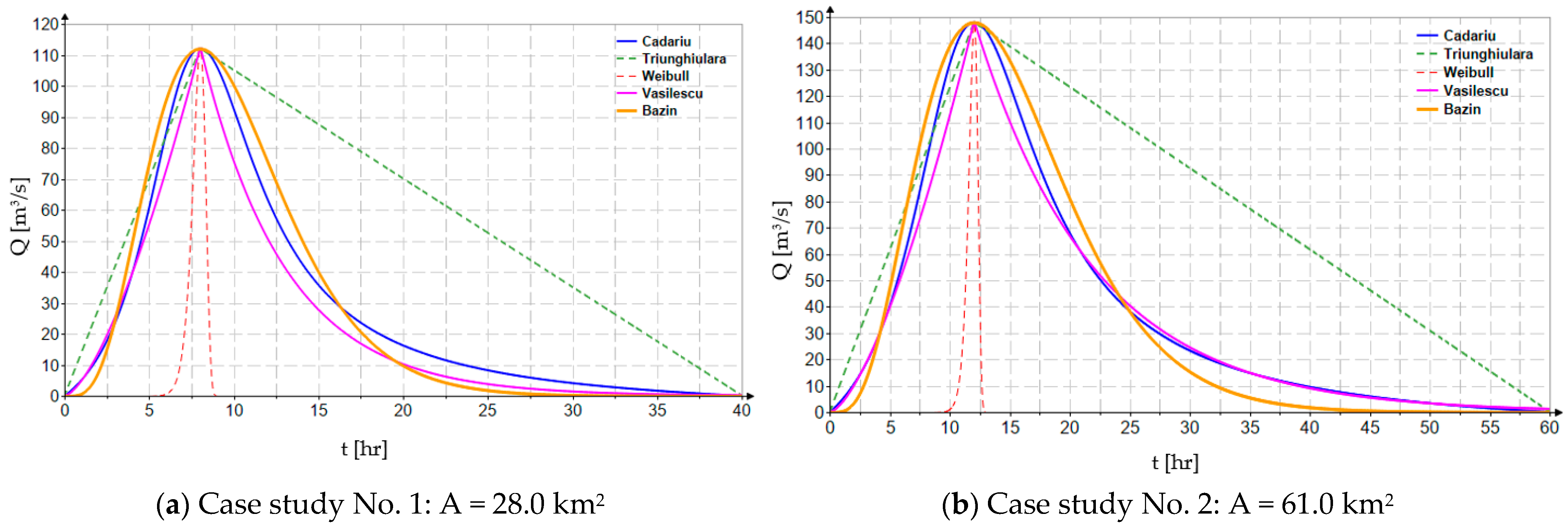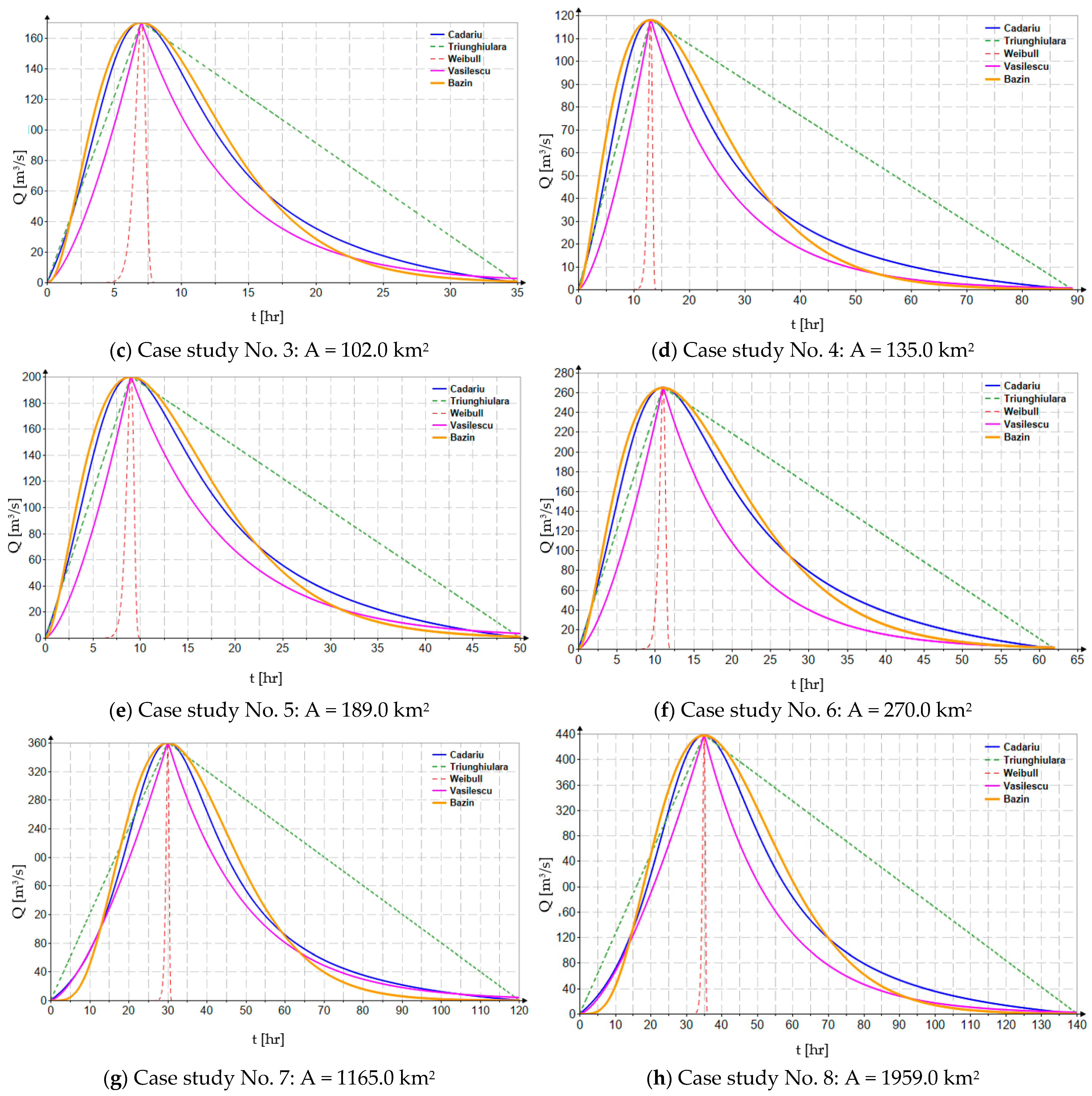1. Introduction
The synthetic hydrograph (SH) is a fundamental tool in hydrology, used to model the response of a watershed to a unit input of excess precipitation over a specified duration. It plays an essential role in hydraulic analysis for the design and verification of hydraulic structures, such as protective levees, dams, and other flood defense works. The SH contributes to determining the maximum water volume that must be retained or released, being crucial for establishing reservoir dimensions and attenuation basin capacities. It is used in hydraulic modeling of flood wave propagation, serving as input data for hydrodynamic models that simulate its downstream movement, assessing the wave’s velocity and height in various river cross-sections. Additionally, it plays an important role in the sizing and verification of levees, allowing the assessment of their stability and height, including the analysis of internal erosion and infiltration effects during extreme events.
Unlike observed hydrographs, which are derived directly from recorded rainfall–runoff events, SHs are constructed using empirical or analytical methods, making them highly adaptable in ungauged or poorly monitored watersheds.
The construction of synthetic flood hydrographs often relies on using different functions for the rising and falling limbs. Sokolovski’s model [
1], for example, employs exponential functions, providing a specific formula for calculating discharge on the rising limb. Other models, such as the Reitz–Kreps model [
2], combine exponential and sinusoidal functions—applying a sinusoidal expression on the rising limb and an exponential relation on the falling limb. Srebrenovic [
3] introduced an approach that uses a composite power–sine function for the rising limb and a power-type function for the falling limb.
In recent years, probabilistic approaches have gained prominence in the development of SHs, offering a more flexible and statistically robust framework for capturing the inherent variability and uncertainty of hydrological processes. Probability distribution functions (PDFs) are particularly useful in this context, as they describe the likelihood of various flow magnitudes occurring over time, allowing for a more realistic representation of runoff dynamics, for the entire shape of the hydrograph.
Commonly employed PDFs in SH derivation include the gamma distribution [
4,
5,
6], Weibull distribution [
7], log-normal distribution [
8], beta distribution [
4,
7,
9], Fréchet distribution [
10], three-parameter Kumaraswamy distribution [
11], two-parameter Pareto distribution [
11], two-parameter inverse Gaussian distribution [
11], two-parameter inverse gamma distribution [
11], also known as the Pearson V distribution, Dagum distribution [
12], log-logistic distribution [
13], also known as generalized logistics distribution, etc.
The gamma distribution is often favored for its ability to capture the skewed nature of runoff hydrographs, while the Weibull distribution is useful for modeling time to peak and recession curves, especially in extreme flow conditions. These distributions help in defining the shape and scale parameters of the hydrograph, thus enabling hydrologists to simulate peak flow rates, time to peak, and recession curves with greater accuracy. For example, in a study conducted on a small mountainous watershed [
14], the gamma and beta distributions provided a superior fit for the rising limb of the hydrograph, accurately predicting peak discharge times. Meanwhile, the Weibull distribution was effective in characterizing the recession limb, reflecting the gradual drainage of runoff over time.
The use of PDFs not only enhances the predictive capabilities of the SH but also facilitates the estimation of design flows for flood risk assessment, irrigation planning, and other water resource management practices. Furthermore, probabilistic modeling allows for the quantification of uncertainty in hydrograph predictions, supporting more informed decision-making processes.
When using these probability distribution functions, it is crucial to ensure that all defining conditions of a synthetic flood hydrograph are met. These conditions include the critical time (time to peak, ), the total duration of the hydrograph (), the peak discharge (), and the shape coefficient of the synthetic flood hydrograph (), which represents the ratio between the flood volume () and the equivalent volume of the rectangle circumscribed to the flood wave ().
A particularly important aspect is the skewness of these synthetic floods, as the rising limb is typically steeper than the recession limb. This skewness must be accurately captured by the chosen PDF, since it plays a key role in the design of hydraulic structures, such as spillways, flood outlets, and in establishing operational rules for reservoirs. Failure to account for this skewness could lead to underestimations of peak flows or miscalculations of recession times, both of which are critical for flood risk management and infrastructure resilience.
In Romania, it is a standard and common practice in hydrology to establish, based on observed floods at hydrometric stations, regional and zonal values for the characteristic parameters of hydrographs. These are average elements of the typical singular flood waves. To establish these average values, series of observed floods at hydrometric stations are used, selecting significant events (usually annual maximum floods or floods caused by rainfall with certain exceedance probabilities). For each flood, the rise time (the time from the beginning of the flow increase to the peak) and the total time (usually defined as the duration until the flow returns close to its initial value) are determined. The observed values are correlated with the morphometric characteristics of the basins: area (A), main river length (L), average slope (S), etc., constructing empirical relationships where the coefficients are adjusted based on multiple regression applied to monitored basins. The obtained values are grouped by hydrological zones or regions with similar characteristics (geology, climate, land use, etc.). The models are tested by comparing synthetic hydrographs with observed ones, adjusting the coefficients to minimize errors.
For ungauged basins, it provides an indirect but well-founded method to estimate the hydrograph parameters. In hydrological modeling, it helps create synthetic hydrographs, useful for the design of hydraulic structures. For frequency analysis, it allows the simulation of hydrographs corresponding to different return periods, even without detailed local data.
Thus, with this information, the unit hydrograph is created, which needs to be scaled by the peak flow corresponding to the desired annual exceedance probability. For ungauged basins, the peak flow is estimated through a similarity analysis with adjacent gauged basins, where a flood frequency analysis (FFA) of recorded peak flow series is conducted to determine the extreme event values associated with the relevant annual exceedance probabilities (p%).
To reduce uncertainties in estimating these peak flows, the frequency analysis should adopt a holistic approach, considering statistical distributions and parameter estimation methods. Given the well-documented advantages highlighted in numerous studies and analyses, it is recommended that Romania adopt the L-moments method—a robust and stable technique, resistant to the influence of outliers and variability in data series lengths [
15,
16,
17,
18,
19].
Thus, considering these regional hydrological approaches for determining the parameters of synthetic flood waves (critical time, total time, flood volume, and flood shape coefficient), the question arises: What is the most suitable and easily applicable formula/relation/probability distribution density function for constructing the synthetic hydrograph, while ensuring all these parameter values are respected?
In this context, the manuscript analyzes several of the most commonly used probability density functions: the Weibull distribution, the triangular distribution, Bazin’s relation, and Vladimirescu’s relation. Furthermore, the manuscript presents a function initially proposed by engineer Radu Cadariu [
20], which represents an elegant solution (a three-parameter rational function) both mathematically and statistically, offering significant advantages over classical approaches (as evidenced by the case study results presented in the paper). Unfortunately, this function has been “forgotten”—whether intentionally or not—in the hydrological technical literature of Romania.
By integrating statistical methods into hydrological modeling, this research seeks to contribute to the development of more reliable and adaptable tools for deriving synthetic hydrographs.
In general, these regionally determined parameters are provided in hydrological studies, where they form the basis for constructing the unit hydrograph and the hydrograph corresponding to the peak flow (associated with the desired annual exceedance probability). This is essential for performing hydraulic modeling to identify floodplain boundaries and flood-prone areas, helping to establish the necessary structural and non-structural flood protection measures for various objectives. These parameters also play a crucial role in analyses of the probabilities and failure mechanisms of protective structures, such as levees, particularly through the piping failure mechanism, where the flood volume is critically important.
Thus, this manuscript presents an analysis aimed at identifying the best model for constructing the peak hydrograph, based on data from locations where these regionally determined parameters were provided.
As innovative elements, approximate relations with errors < 1% are presented regarding the estimation of the parameters of the Cadariu and Bazin functions, innovative elements that help determine the parameters and facilitate the ease of use and application of these functions in representing the synthetic hydrograph. In general (valid for all statistical distributions that can be used to represent the synthetic unit flood hydrographs), the estimation of the function parameters results from solving the following conditions: , , and .
3. Real Case Data
The performances of the analyzed distributions are verified on case studies, in which the values of the characteristic parameters of the flood waves are determined regionally, for locations with different statistical, hydrological, and morphometric characteristics.
The regionally determined parameters are presented in
Table 5.
Figure 2 presents the results obtained for representative case studies in terms of the characteristics and particularities of the river basins.
In the analysis conducted on synthetic hydrograph modeling using probability density functions, the focus was placed on their ability to accurately reproduce the main hydrological characteristics of flood waves: peak discharge, rise time, total flood duration, and shape coefficient. These four conditions are fundamental requirements for constructing a realistic synthetic hydrograph, particularly in ungauged catchments where measured data are lacking.
Among the tested functions, the rational function proposed by Cadariu consistently demonstrated superior adaptability to these conditions. This function, defined by a ratio of polynomials and calibrated according to the basin’s characteristic parameters, provides high formal flexibility, allowing for simultaneous and controlled representation of both the rise time and the shape of the recession limb. Compared to other commonly used functions (e.g., Pearson type III, gamma, beta, log-normal, etc.), the Cadariu function allows more direct control over the hydrograph asymmetry and the positioning of the peak discharge.
Another important aspect is the precise compliance with the total flood duration, without the need for artificial truncation of the density function. While other PDFs require empirical adjustments or numerical methods to close the curve at a given duration, the rational function strictly accommodates this limit simply through the choice of functional parameters, thus facilitating its integration into computational simulation algorithms.
Regarding the flood shape coefficient (often defined as the ratio between rise time and total duration), the Cadariu function is one of the few that allows direct control over this ratio while maintaining mathematical continuity and full differentiability—essential characteristics for propagation analyses and hydraulic modeling.
It is also worth mentioning Bazin’s empirical relationship, which, although formally simpler, produces similar results in terms of the general shape of the hydrograph. It relies on a single shape parameter, and its mathematical expressions are significantly simpler, making it attractive for practical applications or rapid assessment methods. Thus, in contexts where simplicity and computational speed are priorities, the use of Bazin’s relationship may be justified and efficient, with the note that the accuracy of the results still depends on the correct selection of the characteristic parameter.
Table 6 presents the volumes (in hm
3) of the synthetic flood waves obtained using the analyzed probability functions.
The errors between the resulting estimated volume values and the actual ones are highlighted in
Table 7. These errors were determined based on the RME (relative mean error) criteria.
It can be seen that there are large percentage differences between the synthetic flood volumes.
Cadariu’s function and Bazin’s method show zero relative errors (0%), meaning they are explicitly calibrated to conserve the flood volume. They respect a fundamental condition: the total volume of the synthetic hydrograph must equal the observed one or that imposed by hydrological assumptions.
The triangular function has very large and negative deviations (up to −103%), indicating that this simple geometric approach consistently underestimates the flood volume. The main reason is that the triangular function, although it can roughly reproduce the rise and recession times, cannot correctly capture the asymmetry and temporal extension of real floods.
The Weibull function shows large positive errors (90–98%), i.e., it almost doubles the real volume. This is due to its parametric form, where calibration based on characteristic times leads to an exaggerated extension of the flood recession limb, adding a significant artificial volume.
The Vasilescu function shows more moderate errors (6–34%), but still consistent. This suggests that the method captures the asymmetry of the flood better, but it is not strictly calibrated for volume conservation.
The flood volume is a crucial parameter in applied hydrology, as it determines the dimensioning of hydraulic structures: reservoirs, dams, levees, or mitigation basins must be designed not only for the maximum flow (Qmax) but also for the total volume to be diverted or stored. It also controls the efficiency of flood protection measures, where a high maximum flow, but of short duration, has very different impacts compared to a lower flow with a high volume (prolonged flooding, infiltration, and dam saturation). In downstream propagation studies, the volume controls the shape of the hydrograph. An error of 90–100% in the flood volume leads to completely misleading predictions of downstream water levels.
Volume conservation is a fundamental requirement, where any synthetic function must respect the balance between precipitation, losses, and effective runoff. The parameters must be calibrated simultaneously on several criteria: not only on the rise and fall times but also on the volume and asymmetry. Without such calibration, the results can be misleading—a function that correctly reproduces Qmax but has twice the actual volume is not valid for engineering purposes.
Parametric functions (Weibull and Vasilescu) can be useful but require parameter adjustment by optimization methods (e.g., minimizing the squared error between the observed and synthetic hydrographs) to avoid systematic volume errors.










